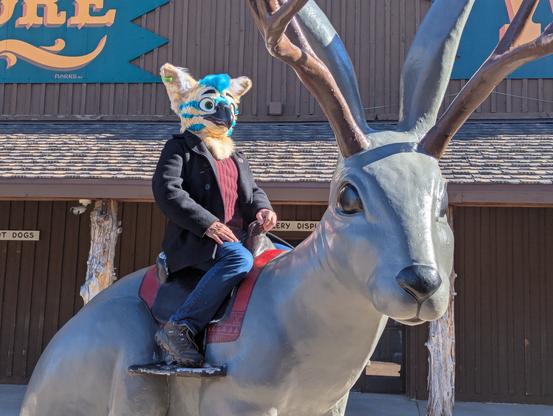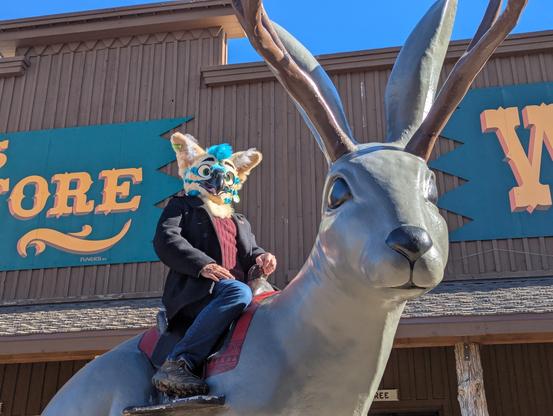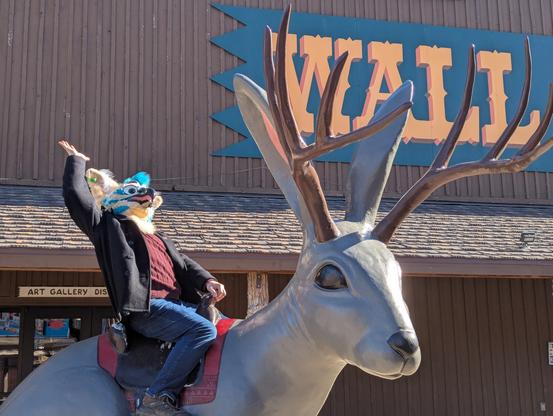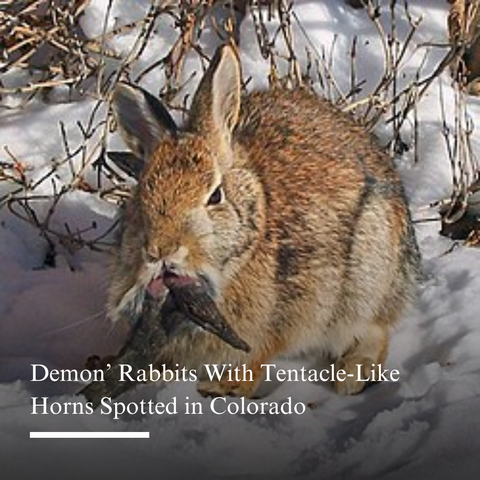do you sometimes wish you could fly away like a dragon into the clouds?
#furry #furryart #rabbit #jackalope #dragon #wolpertinger #sketch
Commission by KoyHazar
Xenoblade Cosplay
Dewey Redfang as Riki
The best Heropon
www.furaffinity.net/user/koyhazar
#xenoblade #xenobladechronicles #furry #furryart #cosplay #riki #jackalope
#traditional #painting #jackalope #littletroublestcg
🎵I'm running wild, livin' fast and free🎵
Mac drawn in the style of a Mobian from the Sonic the Hedgehog universe, I think he'd fit right in ^v^
( 🎨 by @kaitofeesh.bsky.social )
Hello Mastodon! I'm SpiffyGoblin, adult artist and smartass. I'm obviously fond of goblins, but this year I finally created a fursona for myself!
Pop cryptid in the News: Jackalope
An outbreak of Shope papillomavirus in Colorado is in the news for the past few weeks. The virus that causes warty growths in cottontail rabbits can be spread by ticks and usually aren’t fatal to the animal unless it interferes with their eyes or mouth.
Rabbits with severe cases of this condition overlaps with ideas about the infamous horned rabbit, the Jackalope. I’ve seen several displays of news or comments on this story that confirm that people really do not know anything about the disease or the history of the American Jackalope legend. They are confused about what is happening with these rabbits and calling them “Jackalopes”.
Some of the kids are amazed. Jackalopes are REAL! And several media outlets are not capable of making real nature stories not look like clickbait by calling the infected animals “Frankenbunnies” and “demon rabbits” because nothing matters today unless it has a stupidly exaggerated name. Tabloid trash says we’re being “invaded” or “overrun”. Nonsense.
I did find videos and references to “Frankenstein” rabbits from at least 12 years ago, even from the Smithsonian Magazine, so it’s not a new thing, but that doesn’t make it less silly. This should be a learning moment. I think, for the most part, it is, if the audience would just listen instead of being so overdramatic.
Screen cap from a 2013 video of an infected rabbit from MinnesotaI pulled out and revamped my content on jackalopes that I wrote in Pop Cryptid Spectator 3 to revisit this topic.
Pop Cryptid: Jackalope
A major theme of the Pop Goes the Cryptid model is the never-ending dispute about calling something a “cryptid”. Today’s complicated example: the Jackalope – a creature that is well-associated with being a “cryptid” online but that almost everyone who knows some history of cryptozoology will insist is not a cryptid because it’s a mythical creature, a hoax.
With the public now seeing rabbits with horny growths and “tentacles” (you weirdo writers need to stop with the Call of Cthulhu), a realization is happening in the cryptid forums and social media that maybe there was something to the idea of a Jackalope as a real animal. But, it’s not simple or direct. Things that evolve in culture never are.
My reference is On the Trail of the Jackalope (2022) by Michael Branch, a comprehensive book that mostly treats the creature as a cultural creation but also briefly explores the idea of its cryptidness.
Animals suffering from the virus were seen by most hunters as suffering from some disease. It’s not hard to figure out. The dark, grotesque growths don’t resemble antlers. The Jackalope, proper, is an antlered jackrabbit or cottontail. So, to equate the two situations is an error.
The true home of the American Jackalope is Douglas, Wyoming where the first taxidermied example was made. The legend goes that it was created sometime between 1932 and 1940 by Douglas Herrick. This is from Branch’s book:
“One day young Doug and Ralph Herrick went out roaming the green hills hunting for small game to supplement the family supper. Having bagged a jackrabbit, the brothers returned home and tossed the hare’s body onto the floor of their shop in preparation to skin it. Because they had recently butchered a small deer in the shop, a modest pair of antlers already rested on the floor. By a sheer coincidence that would change the boys’ lives forever, the dead rabbit happened to slide up against the deer’s horns so as to make it appear the jackrabbit sported the rack.”
The resulting mount was exhibited at the Hotel LaBonte in the town which was ground zero for the legend and the commercialization of the creature. Creation of Jackalope mounts has become a cottage industry and is now well known worldwide as a symbol of the American West.
“[T]he horned rabbit is unalloyed Americana—a genuine artifact of this country’s folk culture—the mythical beast has also made its way across the oceans and around the world.”
According to the locals, says Branch, about half the visitors to Douglas leave believing the animals are real. Do they believe, or are they just having fun believing? Hard to judge. The same might be said about most cryptids as people like to imagine that tall tales are true because it makes life seem magical. This remains a strong theme in the Jackalope biography.
Jackalope from the video game Red Dead RedemptionThe horned rabbit
Cottontail rabbits with horn-like protuberances over various parts of their bodies, particularly their heads, were found to be infected with a type of papillomavirus. There can be little doubt that such stricken rabbits would be viewed as mysterious, then and now.
Branch notes that the prevalence of the horned rabbit across cultures suggests that they were at least somewhat based on these natural anomalies. But the precursors to the American Jackalope are numerous. The specific Jackalope may be a Wyoming invention, but it was not the first depiction of the horned rabbit.
In the early days of natural history, the “horned rabbit” was assumed to be a real, genuine, unique animal because witnesses said so. Early naturalists such as Conrad Gessner, Joris Hoefnagel (16th century) and others depicted the horned hare as a real animal. Later, other natural historians weren’t so sure, but this uncertainty about its existence and speculation on the cause of horned hares undoubtedly sounds like the modern idea of a “cryptid”. There is a good bet that the horned hare was at least somewhat based on the diseased animals.
There is also the wolpertinger, an even more badass bunny with not only antlers, but fangs and wings. Or, it was a more bizarre mashup of various birds, squirrels, and foxes. Again, it’s unclear if the virus-related growths helped spread this story. But if so, it was for inspiration only, because Wolpertingers are absurd in appearance. Depictions of wolpertingers originated in Bavaria where taxidermied hoaxes were popular in the 1800s with tourists. Therefore, it’s reasonable to say that the Wolpertinger was a valid ancestor of the Jackalope.
Wolpertinger edited from Young Hare, a painting of a hare by Albrecht DürerIs the Jackalope a cryptid?
The world was a different place centuries (or even decades) ago. Ideas and language change. We know more about what’s in the world and what isn’t.
If we go by the general cryptid definition of “an animal/entity that is believed to be real but not recognized by zoology” then the Jackalope can claim the title of an official cryptid. There have been stories of people claiming to see real jackalopes (as in antlered hares) or infected cottontails. There’s a good chance these have been conflated.
Ample evidence shows that most people are entirely ignorant of wildlife in their own backyard, let alone the zoological catalog of known animals. As with everything else in the modern world, we get our information from popular culture, not too much directly from qualified scientific experts. So, it not surprising that an average person would 1.) not know about Shope papilloma infected rabbits and how they look, and 2.) that there is not such animal as an antlered rabbit. For the latter, we have to understand that basic schooling doesn’t teach zoology, and many kids know nothing about nature. (A high percentage of the population does not understand basic geography or scientific explanations about the earth.) So, it is not surprising to me that some people might think jackalopes are plausible. Their appearance in popular culture might suggest to people who didn’t know any better that they are real. This latest hype about “frankenbunnies” also muddies the waters because people are getting poorly sourced “WTF is that!”-type coverage, instead of factual information.
Branch quotes Loren Coleman who runs the International Cryptozoology Museum regarding his inclusion of the Jackalope in the museum: “I would read visitors’ online comments… and they would say things like ‘I didn’t know that the jackalope really existed.’ ” Coleman continues by explaining he reorganized the exhibit to depict the Jackalope along with other hoaxes. To me, there is a lot to unpack in that anecdote. Do we really know which cryptid is a manufactured hoax, which are imaginary creatures that people wish to be real, which are mistaken IDs influenced by lore and campfire tales, and which are real animals? The line is very blurry and all the information isn’t available to most people.
The fact is, Pop Cryptids are what’s happening. Any weird animal that is legendary, mythical, or just plain-old manufactured on a whim are being called “cryptids”. And there is nothing any “cryptozoologist” can do to change it, no matter how much they indignantly rant about it.
A Jackalope design for pins and tees on TeePublic.People are viewing cryptids through various lenses (zoological, artistic, historical, cultural, etc.) If people wish to believe horned rabbits (jackalopes, wolpertingers, or other variations) are real animals hopping around in an alternative reality, that’s OK by me, as long as they aren’t declaring that in biology class. It’s important to recognize that horned rabbits have a history that can be legitimately viewed with a zoological lens. However, the history is fraught with flips, twists, and turns.
https://www.youtube.com/watch?v=M0y-RAXsEQ8
#cryptids #Frankenbunnies #Jackalope #popCryptids #rabbits #ShopePapillomaVirus
Believed to be the source of the jackalope myth, this condition is caused by a relatively common virus. Shope papillomavirus causes wart-like growths that protrude from their faces like horns.
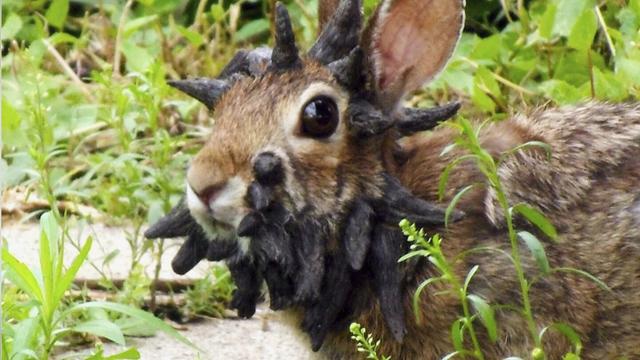
Rabbits with virus-caused 'horns' have been spotted in Colorado
Some cottontail rabbits in Fort Collins, Colorado, have been drawing attention because they have wart-like growths on their faces that look like horns. The rabbits are infected with the relatively common Shope papillomavirus. The virus likely inspired the centuries-old jackalope myth. It also helped scientists learn about the connection between viruses and cancer, such as the human papillomavirus that causes cervical cancer. Experts say the virus cannot spread to other species. The growths don’t harm rabbits unless they grow on their eyes or mouths and interfere with eating. Rabbits’ immune systems are able to fight the virus. And once they do, the growths will disappear.
Fort Collins, Colorado, residents have spotted wild rabbits with black horn-like growths on their heads.
#DemonRabbits #ColoradoWildlife #Jackalope #ViralRabbits #HornedRabbits #NatureMysteries #ColoradoNews #AnimalFolklore
Am I always looking for personalized license plates? YES HUH! I didn't see Doctor Doolittle, but I saw MSDULTL, a JAKLOPE, and of course, CTS4LF. Football season is coming!
#Montana #Billings #licenseplates #yes #huh #doolittle #jackalope #cats #catsforlife #football

